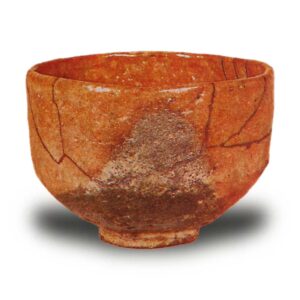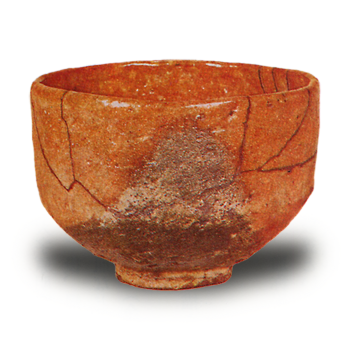
A Pallaki specialty. Raku ware tea bowl, red, one of the seven Chojiro types. It is called “Hayafune” because Sen no Rikyu brought this tea bowl from Kyoto by a fast boat while he was in Osaka. The mouth is slightly bent, and the eyes form a step from the waist to the top of the bowl.
The height is not very high, and there are two “Gotoku” marks on the rim. The yellowish red glaze below the waist on one side and the blue rat glaze from below the rim of the mouth to the entire surface of the base on the other side form a one-sided body, and the body also has a powdery serpentine scorpion glaze. The body of the vessel also has a powdery serpentine scorpion glaze, and there are also areas where the glaze has been partly wetted, making this a unique example among Chojiro’s works, which vary widely in glaze quality. The interior is covered with red glaze on all sides, and there are five five “gotoku” marks. This is the most famous tea bowl among the seven types since ancient times, with a beautiful glossy glaze both inside and out. When Rikyu first owned this bowl, Ujisato Gamo, Sansai Hosokawa, and Oribe Furuta requested it, and it was later given to Ujisato. When it was handed down to Soyu Daimonjiya in Kyoto, Bunemon Kikyouya in Kyoto paid 8 kanmoku of silver, a toolmaker in Kyoto paid 1,000 ryo, and a man from Osaka paid 1,200 ryo for it, but he was unable to obtain it. In 1876 (9th year of Meiji), it was purchased by Togita Rogin, a tool dealer in Osaka, and in the spring of 1880 (same year of the 3rd year of Meiji), it was given to Kameda Korean in Kanazawa, and later entered the Fujita family from Kameda. It is now in the collection of the Hatakeyama Memorial Museum. (Kokin Meimono Ruiju, Chaware Meikatahen, Honcho Toki Novelogue, Taisho Meikikan, etc.)



